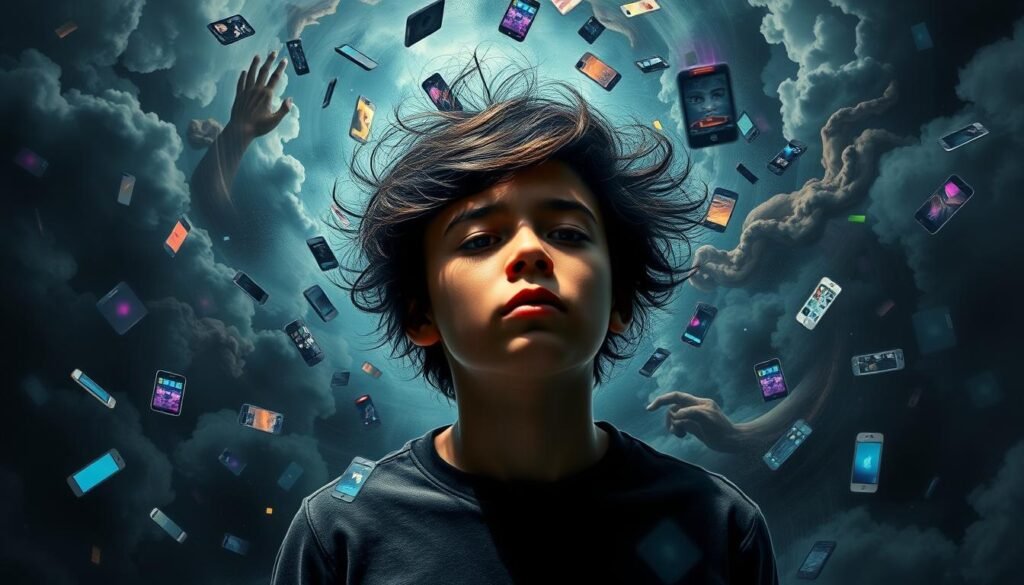I recently read Jonathan Haidt’s book, “The Anxious Generation.” It talks about the mental health crisis among today’s youth, focusing on Gen Z’s anxiety. The book highlights how smartphones, social media, and overprotective parenting contribute to rising anxiety and depression. It points out that teens spending over 3 hours daily on social media are twice as likely to experience anxiety and depression symptoms.
Anxiety in the digital age is a big concern, with depression seeing a 150% rise since 2010. As someone worried about young people’s well-being, I think it’s crucial to understand what causes this crisis. The book by Jonathan Haidt offers insights into how technology and parenting styles affect Gen Z’s anxiety.
Key Takeaways
- The average daily social media use among adolescents is 4.8 hours, which can lead to double the risk of anxiety and depression symptoms.
- Depression has increased by 150% since 2010, with 20% of 12- to 17-year-olds experiencing at least one major depressive episode.
- The rise of smartphones and social media has significantly impacted youth mental health, with notable correlations between phone usage, social media activity, and mental health concerns.
- Parental “safetyism” can contribute to the problem of youth mental health, while a phone-free policy can have dramatic positive effects on students’ happiness and stress levels.
- Jonathan Haidt suggests raising the age of legal “internet adulthood” from 13 to 16 as a potential policy change to address the mental health crisis.
Understanding ‘The Anxious Generation’ by Jonathan Haidt: A Deep Dive
Exploring mental health in youth, I find the rise in teenage anxiety alarming. Jonathan Haidt’s ‘The Anxious Generation‘ sheds light on this issue. It shows how digital addiction leads to insecurity and low self-esteem in teens.
Since 2008, anxiety disorders in college students have jumped by 134%. Smartphones and digital media introduced between 2010 and 2015 have contributed to this rise. Teens now spend less time with friends and get less sleep, affecting their mental health.
Key Themes and Messages
The book talks about social media’s impact on mental health. It points out how girls, exposed to social media during puberty, are hit hard by visual comparisons. Boys, on the other hand, are drawn to video games and pornography, affecting their social skills.
The U.S. Surgeon General warned about social media’s dangers for kids and teens in June 2024. The book suggests solutions like no smartphones before high school and no social media before 16. These steps could greatly improve children’s well-being in just two years.
| Issue | Statistic |
|---|---|
| Anxiety disorders among college students | 134% increase since 2008 |
| Sleep deprivation among teenagers | Decrease in sleep quantity and quality |
| Social media impact on mental health | Rising rates of anxiety, depression, self-harm, and suicide |
The Digital Age’s Impact on Youth Mental Health
The digital age has deeply affected youth mental health. Social media addiction, helicopter parenting, and changing parenting styles have created a perfect storm. Jonathan Haidt says the link between technology and mental health issues is clear. We need a new way to tackle this problem.
The loss of play-based childhood and the rise of phone-based childhood are big problems. Smartphones and social media harm young people’s nerves and spirits. This has led to more anxiety, depression, and self-harm. Girls are hit hard by this shift, losing time in the physical world for the virtual one.
To fix this, we should give kids more time to play outside without adults. We should also delay giving them smartphones until high school.
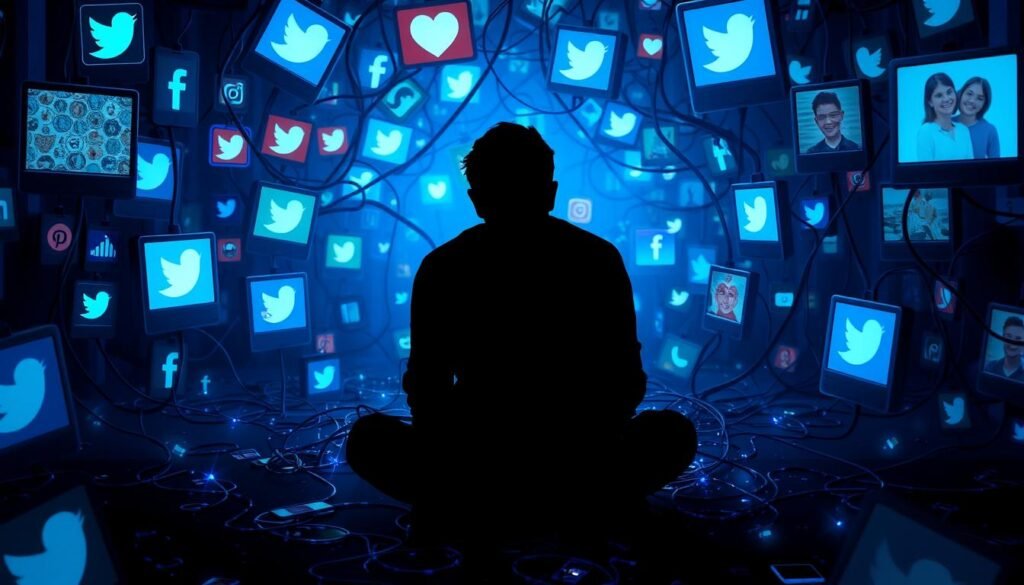
- Spending more time appreciating nature
- Playing with friends
- Doing age-appropriate chores
By doing these things, we can help our young people become more resilient. Haidt stresses the need to improve mental health support and education. We must consider the effects of social media, helicopter parenting, and parenting styles on their wellbeing.
How Social Media Shapes Teen Psychology
We’re learning more about how social media affects teen anxiety and mental health. The crisis in Gen Z’s mental health is alarming. Experts say technology plays a big role in this issue. In the US, teen depression has risen by over 150% since 2010.
Teens often feel bad when they compare their lives to what they see on social media. This can make them feel not good enough and lower their self-esteem. Studies show that social media use is linked to anxiety and depression in teens, hitting girls harder.
Several factors contribute to Gen Z’s mental health crisis:
- Digital addiction patterns, with teens spending more time on social media platforms
- Social validation seeking behavior, with teens presenting curated versions of themselves online
- The impact of social media on mental health, which varies among individuals but can be distressing during adolescence
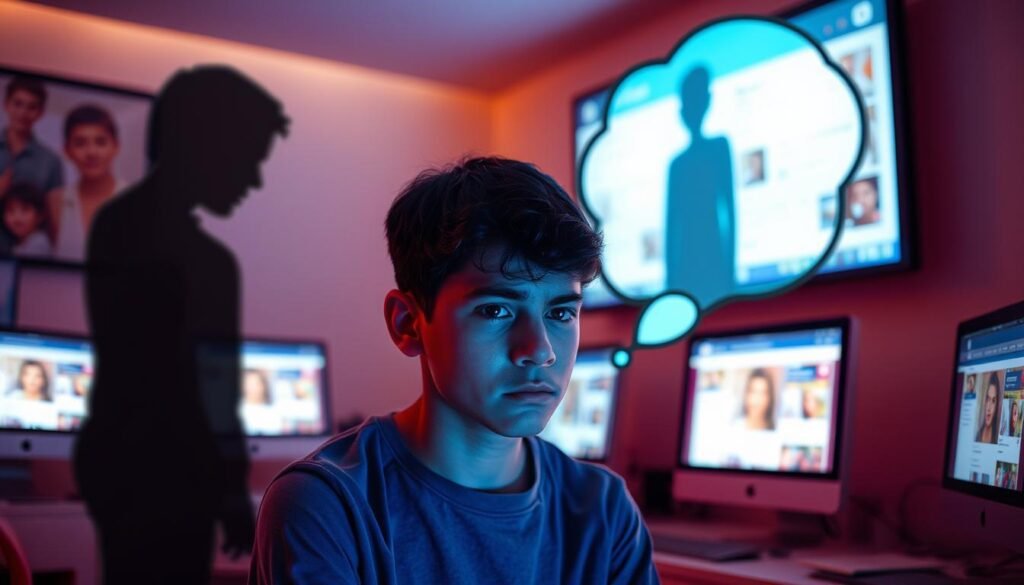
We need to tackle these issues and make the online world safer for teens. By understanding technology’s effect on mental health and teaching teens to use social media wisely, we can help ease the crisis in Gen Z.
| Year | US Teens Reporting Major Depressive Episode |
|---|---|
| 2010 | 10.3% |
| 2020 | 26.4% |
Modern Parenting Styles and Their Consequences
As a parent, we all want to keep our kids safe. But overprotective parenting can actually harm them. It might make them more likely to feel teenage depression and anxiety. Jonathan Haidt says we often overprotect our kids in real life but underprotect them online.
This mix can hurt our kids. They might not learn how to handle problems on their own. Too much screen time makes things worse. So, parents should think about a screen time detox for their kids.
Here are some tips for better parenting:
- Encourage outdoor play and face-to-face interactions
- Set limits on how much screen time they have
- Show them how to handle challenges in a healthy way

By striking a balance, we can help our kids grow strong. They’ll be ready to face the world with confidence.
| Parenting Style | Consequences |
|---|---|
| Overprotective | Increased risk of teenage depression and anxiety |
| Permissive | Increased risk of screen addiction and decreased resilience |
| Authoritative | Healthy balance between protection and freedom, promoting resilience and coping mechanisms |
The Hidden Connection Between Screen Time and Anxiety
Exploring the link between screen time and anxiety is fascinating. It’s linked to mental health, as seen in jonathan haidt’s work. Smartphones and more screen time have led to high mental illness rates in teens, mainly girls. This is known as “The Great Rewiring” and affects young adults a lot.
Studies show that kids need a balance of screen time and play. It’s good to delay phone and social media use for them. Schools should be phone-free, and kids need safe spaces and digital products designed with their safety in mind.
Physical Effects of Extended Screen Use
Long screen time can harm kids physically. Some effects include:
- Distraction and decreased focus
- Increased risk of mental health disorders
- Impact on sleep patterns and overall well-being
Digital Boundaries and Mental Health
Digital boundaries are key for mental health. You can set limits on screen time and encourage physical activity. Also, face-to-face interaction and social skills are important.
- Setting limits on screen time
- Encouraging physical activity and outdoor play
- Promoting face-to-face interaction and social skills
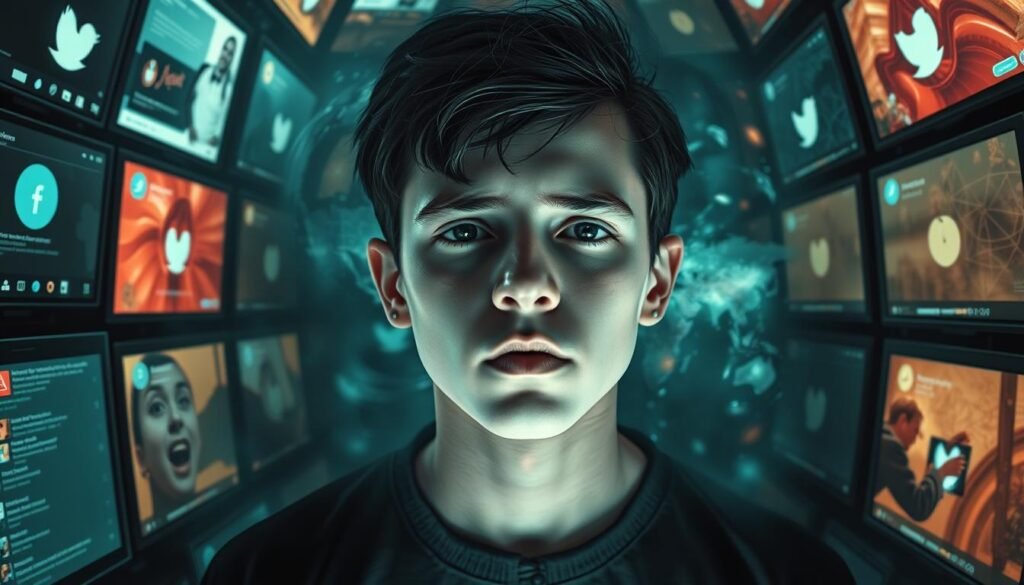
Creating Healthy Tech Habits
Healthy tech habits are crucial for young adults. Being mindful of screen time and setting digital boundaries helps. Jonathan haidt’s lessons show finding a balance is essential for good mental health.
| Age Group | Screen Time Limit | Recommended Activities |
|---|---|---|
| Children (6-12) | 1-2 hours | Outdoor play, reading, drawing |
| Teenagers (13-18) | 2-3 hours | Physical activity, socializing, learning new skills |
Building Resilience in the Digital Era
Reflecting on the digital age’s effect on youth mental health, I see the need for resilience. AJ Juliani points out a rise in teen mental health issues from 2010 to 2015. This is linked to social media’s impact.
Teen mental health has worsened, with more depression, anxiety, self-harm, and suicide since 2012. The rise of social media and smartphones is alarming. We must tackle the causes of this problem.
Outdoor Activities and Mental Wellness
Outdoor activities boost mental wellness, reducing anxiety and improving overall health. They offer several benefits:
- Reduced stress and anxiety
- Improved mood and self-esteem
- Increased physical activity and exercise
- Enhanced social connections and community building
Face-to-Face Connection Benefits
Face-to-face interactions are key for youth mental health. They foster socialization, empathy, and deep conversations. This helps counteract social media’s negative effects.
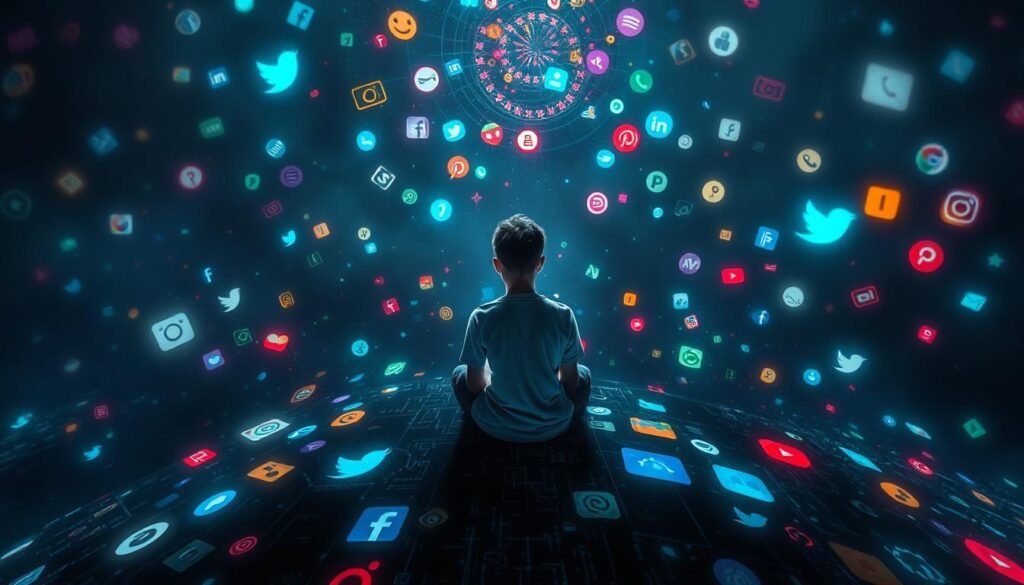
By adding outdoor activities and face-to-face interactions to our lives, we can build resilience. This promotes mental wellness, reducing anxiety and the impact of social media on mental health.
| Activity | Benefits |
|---|---|
| Outdoor activities | Reduced stress and anxiety, improved mood and self-esteem |
| Face-to-face connections | Increased socialization, empathy, and deep conversations |
Practical Solutions from Haidt’s Research
Jonathan Haidt’s research shows us how to tackle teenage anxiety and social media addiction. His book, “The Anxious Generation,” sheds light on how parenting styles affect young people’s mental health.
Haidt believes cutting down on screen time and fostering real-life connections are key. He suggests phone-free days, like the “Phone Free Friday Summer Challenge.” He also recommends outdoor activities and face-to-face interactions.
Here are some key takeaways from Haidt’s research:
- Reducing screen time can help alleviate teenage anxiety and social media addiction.
- Promoting real-life connections and outdoor activities can help young people develop healthy coping mechanisms.
- Parenting styles that prioritize independence and self-reliance can help children develop resilience and better mental health.

By using these practical solutions, we can create a healthier environment for young people. Haidt’s research highlights the need to tackle teenage anxiety and social media addiction for a brighter future.
Revolutionary Approaches to Teen Mental Health Support
Looking into the mental health crisis in Gen Z, I see how tech affects their mental health. Jonathan Haidt teaches us to rethink how we tackle this issue. He says we need to change education and community support.
The school system can help a lot with teen mental health. Adding mental health lessons to classes can teach young people how to take care of their minds. Also, having peer groups and mentors can give teens a place to share their feelings.
Educational System Changes
Some possible changes in schools include:
- Adding mental health lessons to classes
- Training teachers to support mental health
- Making schools safe and supportive
Community Support Strategies
Community support can be:
- Peer support groups
- Mentorship programs
- Local mental health services
By trying these new ways, we can help Gen Z’s mental health. It’s time to act and make a better future for our young people.
| Approach | Description |
|---|---|
| Educational System Changes | Integrating mental health education into school curricula, providing teacher training, and creating safe school environments |
| Community Support Strategies | Peer support groups, mentorship programs, and community-based mental health services |
Conclusion: Creating a Healthier Future for Gen Z
Jonathan Haidt’s “The Anxious Generation” sheds light on the mental health of today’s youth. The rise in anxiety and depression among Gen Z is linked to smartphones and social media. These tools have become major obstacles to their wellbeing.
To improve Gen Z’s future, we need to change how we educate and support them. Haidt suggests delaying their access to smartphones and social media. He also recommends more unsupervised play and face-to-face interactions. This way, Gen Z can develop the skills needed to succeed in today’s world.
Reflecting on “The Anxious Generation,” we see a need for a new approach to supporting mental health. We must focus on the developmental needs of young people. By balancing technology with real-world experiences, we can help Gen Z face the modern world’s challenges.

